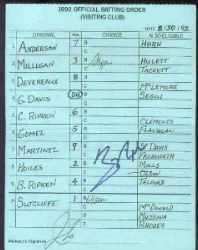1959 Topps #535 Ruben Gomez SCARCE HIGH # (Phillies)


Please wander around the website for more info, prices, values & images
on vintage baseball, football, basketball, hockey, sport and non-sports cards.
1971 Kellogg's1971, Kellogg's second and by far scarcest and most valuable set, contained 75 different players on 2 ¼” by 3 ½” cards. The cards were plastic coated giving them a 3-D look !!! The plastic coating also made high grade cards nearly impossible find. Over time and the elements, most cards would curl making light and heavy cracks very common.As opposed to Kellogg's other issues which were available from the company as complete sets, 1971 Kellogg's cards were ONLY available one in each specially marked box of Kellogg's cereal. The only way to complete your 1971 Kellogg's set was to pester mom to buy, buy, buy more boxes of cereal.
In addition to the 75 different players, numerous scarcer variations exist
with minor differences in the stats on back. In addition, all 75 cards and
some variations are found with 2 different forms of copyright on the back: The "toughest" cards appear to be: # 7 Alou (1970 Oakland NL) # 28 Wright (Angles Crest Logo) # 54 Johnson (Angles Crest Logo) # 64 Fregosi (Angles Crest Logo) # 70 Osteen (No Number on back) # 2 Seaver (ERA 2.81) # 41 Gaston (113 Runs) # 65 Rose (RBI 485) |

Authentic Major League SIGNED |

Vintage Baseball Card Auction terminology
Register:With name, address & email so we can
contact you after auctions with your winning bids.
Click for more info on my Weekly Vintage BASEBALL CARD AUCTIONS
2 Types of Bidding: [YES] / [NO] auction bids - Click on YES button to make only the next bid. [MAXBID] auction bids - Enter MAXIMUM you would bid on this item. If outbid, auction software makes the next bid if is not more than your auction [MAXBID]. Minimum or Start Bid: More expensive auction items may have minimum or starting bids. Saves time rather than auction bids going up .25 at a time, taking many dozens of bids to reach even fractions of value. Reserve Bid: "Reserve" auction bids come into play after an auction ends. If "Hammer" price is less than "Reserve" bid no sale. Not very auction bidder friendly.
|

Cabinet Card Were oversized trading cards featuring paintings issued mostly 1910-1915.
Card Show is a gathering of dealers & collectors looking to buy/sell/trade sports cards and memorabilia.
Card Stock is the material a card is printed on. Usually paper-based, today companies play with the card stock and sometimes it appears to be wood or leather or see-thru acrylic ...
Cello Pack is a card pack whose wrapper is see-thru plastic. Usually the top & bottom cards are seen. Unopened cello packs showing major stars and rookies sell for heavy premiums.
Centering is the balance of the borders: top/bottom & left/right. On perfectly-centered cards, top/bottom borders match as do the left/right borders. Centering is presented as a set of numbers & directions and often included with the grade. Perfectly-centered is "50/50 t/b" AND "50/50 l/r". As centering gets worse, one number increases and the other decreases. For example: 90/10 t/b is considered extremely off-center top to bottom. The numbers add up to 100 (50/50, 60/40, 90/10 ...).
Certificate Of Authenticity (COA) A document used to verify legitimacy of a collectible. NOTE: Keep in mind that COA's are easier to fake then autographs.
Common A card of a non-star player is considered a "Common" as opposed to cards of a star players or specialty/subset cards such as league leaders, teams cards, World Series cards...
Condition (Grade) Centering, corner wear, photo clarity, edges, creases, print flaws ... all combine to determine a card's condition or grade. Along with rarity/scarcity it is the major factor in a card's value.
Crease Defect usually caused by bending the card. Hard to see, or not, a crease lowers the card's grade (VG or lower) and greatly diminishes it's value.
 These are the official lineup cards SIGNED BY THE MANAGER & given
to the home plate umpire before the game with the team's line-up
& batting order !!! Making them even neater, often managers made
lineup changes on these cards throughout the game.
These official lineup cards were SIGNED BY THE MANAGER and presented
to the home plate umpire before the game. They detailed the team's lineup and
batting order. Managers often made lineup changes on these cards throughout
the game, making them even more unique.
These are the official lineup cards SIGNED BY THE MANAGER & given
to the home plate umpire before the game with the team's line-up
& batting order !!! Making them even neater, often managers made
lineup changes on these cards throughout the game.
These official lineup cards were SIGNED BY THE MANAGER and presented
to the home plate umpire before the game. They detailed the team's lineup and
batting order. Managers often made lineup changes on these cards throughout
the game, making them even more unique.
